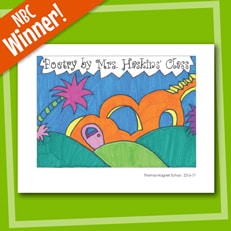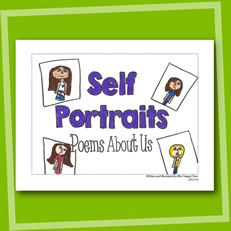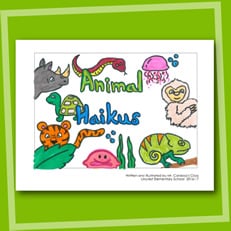 Poetry is a way to introduce a different style of writing as well as a chance to explore rhyming, phonetics and verse structure.
Poetry is a way to introduce a different style of writing as well as a chance to explore rhyming, phonetics and verse structure.
The study of poetry at this age also allows your students to express creativity as they figure out how to fit their ideas to a particular style of poetry.
Combined with an illustration these poetry-centric project ideas are all great for creating a memorable classbook.
2nd Grade Writing: An Introduction to Poetry
The study of poetry doesn’t have to be extremely complex, so even the youngest learners can master this subject.
Introduce your students to four of the most relatable and simple poem structures, which include acrostic, autobiographical, rhyming (or limericks) and haiku.
Acrostic Animals
In an acrostic poem, a word or a person’s name is written vertically, and each letter begins a line of the poem. The easiest way to introduce this type of poetry to your students is to just show your students what an acrostic poem looks like. Make sure you use a word that is familiar to them as an example.
Another approach might be to take a word, such as the season you’re in when you do the lesson: F-A-L-L or S-P-R-I-N-G, and then put together an example of an acrostic poem based on the season’s characteristics.
PROJECT IDEA
Once your students get the hang of what an acrostic poem is and how to write one, ask them to pick their favorite animal and write an acrostic poem that describes the animal. Chances are your students love animals, so this project should get them excited about writing. And while spelling might be an issue, add a twist by allowing them to make up an animal! Order a classbook publishing kit and have your students bring their animals to life, in a “wild” classbook.
All About Me
Autobiographical poetry, also sometimes called bio poems, is a chance for your students to write about what they know — themselves!
While autobiographical poems don’t normally rhyme, they do follow a similar pattern or style. The format of a bio poem helps your students see the structure and understand what elements they will need to fill in about themselves when they write their poem.
Present a bio poem about yourself—your students will get a kick out of learning more about you and it’s a great example for them!
PROJECT IDEA
Use this draft worksheet to help your students prepare their autobiographical poem. This is a good chance for your students to participate in group or partner work while they brainstorm what they want to include about themselves (and how they see themselves). Once you give your students the template for the actual poem, include a small homework assignment of reading through it with their family. The exercise could help your students enhance the poem with input from family members.
Add a self-portrait and this project will make a great book when turned into a class keepsake!
Are you Enjoying this Content?
Limerick L-O-L
Limericks will likely bring about some giggles in your classroom. Your students will enjoy this silly style of poetry, with an interesting rhyming structure.
Limericks are five-line poems where the first, second and fifth lines rhyme and then the third and fourth rhyme with each other.
You’ll need several good examples to demonstrate how limericks often begin with either the phrase, “There once was a … named …” or “I once met a … from …” and often talk about something funny that happened or a silly thing that the animal/person/imaginary thing did.
There is a fun series of books called “There was an Old Lady Who Swallowed..,” which starts with the traditional “fly” rhyme that you may have heard, but then there are variations for holidays and other fun topics that might be a silly way to demonstrate how limericks work.
PROJECT IDEA
Now that your students are familiar with limericks, you can give them a template and let their imaginations run wild. It might help to have them plan out the rhyming words, but even with the template version, you should receive quite a bit of silliness back that show off your students’ creativity.
Have your student’s draw something silly to accompany their poem, and then put their poems and drawings into a classbook with our free classbook publishing kit. You will have a very funny classbook that everyone can enjoy for years to come!
A Bouquet of Haikus
An excellent opportunity to work on understanding how to listen for syllables is haiku poetry. Haiku poetry follows a strict structure of three lines: the first line has five syllables, the second has seven and the third has five.
The haiku, which started in Japan, does not rhyme, so your students don’t need to worry about that when picking the words/syllables in their short poems.
If you’re working with your students to remember the syllable structure of 5-7-5, follow this link to see another teacher’s clever visual.
PROJECT IDEA
After your students feel comfortable with the way to set up a haiku, then you can start working on the actual poems. Since most haiku poems focus on nature, you may narrow the topic down to flowers—perhaps a good idea for the spring and could work across your curriculum as you talk about flowers in science.
Have each student pick a different flower, name it and describe its various traits. To complete your project, your students should make a drawing of their flowers, even including an illustration of themselves in the flower’s center. Have your students complete the final touches of their design and you will be able to create a beautiful classbook full of haikus.
Additional Resources
If you’re in search of additional ideas to help your students with their writing skills, then take a look at our teacher’s lounge, where you’ll find helpful ideas and more.
While you’re there, make sure you sign up to receive your free classbook publishing kit. After seeing how excited your students are after receiving their books, you just might decide to make it an annual project for every class!









